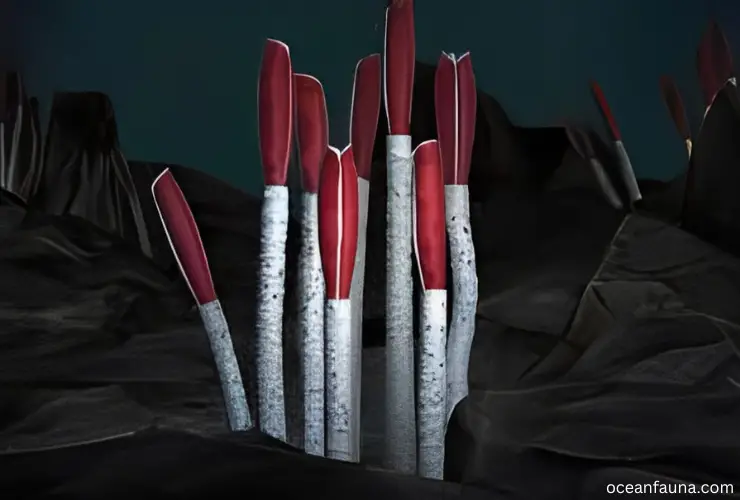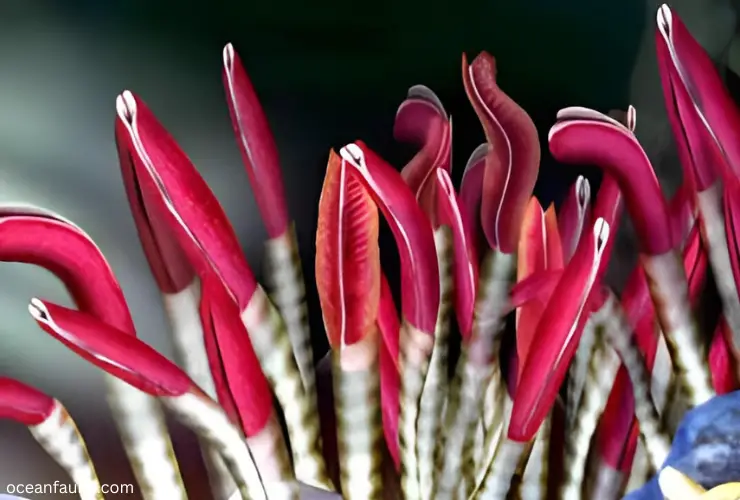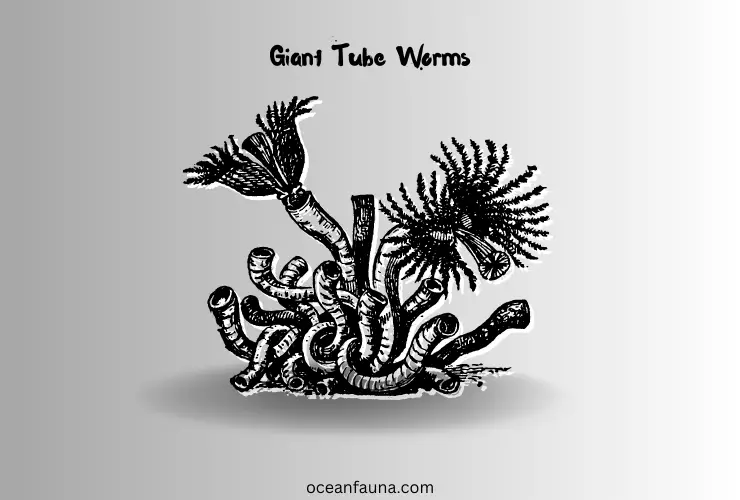Giant tube worms are among the most remarkable marine creatures on earth. They live in very deep and dark parts of the seafloor, where they survive without needing any sunlight.
The tube worm’s body is made up of a tough outer shell, which helps protect them from predators. Inside this shell is a soft inner tissue filled with hemoglobin that stores oxygen and gives the worm its distinctive red color.
Marine enthusiasts have so many questions about this marine creature. In this article, I will try to describe them in detail.
About: Giant Tube Worms
| Category | Information |
| Common Names | Giant Tube Worm |
| Scientific Name | Riftia pachyptila |
| Order | Sabellida |
| Family | Siboglinidae |
| Habitat | Hydrothermal vents |
| Distribution | Pacific Ocean |
| Size | Up to 10 ft long and 1.6 inches in diameter |
| Life Expectancy | Up to 250 years |
Giant tube worms (Riftia pachyptila) are deep-sea creatures inhabiting hydrothermal vents in the Pacific Ocean. These worms can grow up to 10 feet long and have a diameter of up to 1.6 inches. They have a unique and fascinating relationship with the bacteria that live inside their bodies.
The giant tube worm’s body consists of a slender tube made of chitin, which is the same material found in the exoskeletons of insects and crustaceans. The tube worm attaches itself to the hydrothermal vent using its roots, called “byssal plumes.” These roots are made up of tough, fibrous tissues that protect the worm from the high-pressure environment found in the deep sea.
Once attached, the giant tube worm begins to feed on the chemicals produced by the hydrothermal vents. The worm’s digestive system is filled with bacteria that convert the chemicals into food for the worm.
These bacteria produce energy via chemosynthesis, a process by which inorganic compounds are converted into organic matter. The worm absorbs this organic matter and grows continuously.
The giant tube worm’s association with bacteria is unique because these bacteria produce energy through chemosynthesis rather than photosynthesis, which is the primary mode of energy production in most other organisms. This mutually beneficial relationship is known as symbiosis.
Giant tube worms have been found to survive in environments with temperatures up to 54 °C and can tolerate enormous pressure, up to 200 times that of sea-level atmospheric pressure. Due to the extreme conditions in which they live, humans rarely see them.
Most Interesting Facts about Giant Tube Worms
- Giant Tube Worms are found exclusively in deep-sea hydrothermal vents, where temperatures can reach up to 54°C.
- They have no eyes, mouth, or digestive system and rely solely on their bacterial symbionts for nutrition and energy.
- The lifespan of giant tube worms is estimated to be anywhere between 150 to 250 years.
- Giant tube worms have a unique hemoglobin that allows them to absorb oxygen from the water, even at very low levels.
- Even though they are stationary creatures, they can move short distances by ‘swimming’ in their tubes.
- They reproduce only once in their lifetime, and their offspring must find their way to a hydrothermal vent in order to survive.
- They lay eggs that are fertilized by the sperm released by other giant tube worms.

Anatomy of Giant Tube Worms
Giant tube worms are marine invertebrates that are found near deep-sea hydrothermal vents. They belong to the phylum Annelida, and their unique adaptations allow them to thrive in harsh environments that would otherwise be uninhabitable. In this article, we will take a closer look at the anatomy of these fascinating creatures.
Body Structure
Riftia pachyptila has a tubular body that is divided into several segments. The body is composed of a tough, chitinous exoskeleton that protects it from the external environment. The head of these worms contains the mouth, which is surrounded by a ring of tentacles used for filtering water and capturing food particles. The tentacles are covered with cilia that help to move food toward the mouth.
Respiratory System
The respiratory system of giant tube worms is one of their most remarkable adaptations. These creatures lack a mouth-to-anus digestive system like most other animals and a respiratory system that relies on oxygen dissolved in water.
Instead, giant tube worm has a symbiotic relationship with chemosynthetic bacteria that live inside its body. These bacteria can use the hydrogen sulfide released from the hydrothermal vents to produce energy, and in turn, they release oxygen that the host worm uses for respiration.
Circulatory System
The circulatory system of giant tube worms is also unique. They have a closed circulatory system that is composed of a dorsal blood vessel and several smaller lateral vessels. The blood carries oxygen and nutrients to the various parts of the body, and waste products are removed through a series of tiny pores in the exoskeleton.
Nervous System
Giant tube worms have a rudimentary nervous system that is concentrated in the area around the mouth. The mouth is surrounded by a ring of ganglia that work together to coordinate the movement of the tentacles and the ingestion of food.
Do Giant Tube Worms Consume Food?
No, Giant Tube Worms do not consume food in the traditional sense. They rely on a symbiotic relationship with chemosynthetic bacteria living in their gut to transform sulfur compounds into energy. These bacteria use a process called chemosynthesis to generate energy from the sulfur, which is then used by the worms to survive.
The worms have no mouth or digestive system and rely entirely on this symbiotic relationship for their survival. This unique adaptation allows the Giant Tube Worm to thrive in the extreme environment of deep-sea hydrothermal vents, where traditional food sources are scarce.
Where Do Giant Tube Worms Live?
Giant tube worms inhabit the Pacific Ocean, particularly around deep-sea hydrothermal vents found at an average depth of 5,000 feet. These specialized worms live in communities with shrimps and crabs and are exclusively found in environments with hydrothermal vent fluid emerging from the earth’s crust.
Specifically, the tube worms are attracted to vent flow with high levels of sulfide and temperatures reaching up to 54°C. Remember, not every vent is colonized by these creatures, as they carefully select a specific physico-chemical environment that suits their needs. Overall, giant tube worms are a unique and fascinating species that thrive in some of our planet’s most extreme and hostile conditions.
What Is the Lifespan of Giant Tube Worms?
Giant tube worms are fascinating deep-sea creatures that can live up to 250 years. These unique creatures are found near hydrothermal vents on the ocean floor, where they thrive in extreme conditions that would be hostile to most other animals.
The lifespan of giant tube worms is determined by several factors, including their environment, diet, and genetics. These worms have a unique relationship with chemosynthetic bacteria, which live inside their bodies and produce energy from chemicals in the vent fluids. This symbiotic relationship allows the worms to survive in an environment without sunlight or food sources.
The life cycle of giant tube worms is also unique compared to other marine animals. Adult worms only reproduce once in their lifetime, and their offspring must find their way to a hydrothermal vent to survive. This makes their reproductive success incredibly important for the survival of their species.
In addition to their longevity and unique life cycle, giant tube worms have several other interesting adaptations that help them survive in their harsh environment. They have no mouth or digestive system and rely solely on their bacterial symbionts for nutrition. They also have specialized hemoglobin that allows them to absorb oxygen from the water, even at very low oxygen levels.

How Do Giant Tube Worms Reproduce?
Giant tube worms, which are found near deep-sea hydrothermal vents, reproduce through a process involving the release of eggs into the water for fertilization. The fertilized eggs then develop into larvae that swim down to attach themselves to rocks.
Once attached, the larvae continue to develop into tiny worms. At this stage, the worms possess a primitive mouth and gut, which allows for the entry of symbiotic bacteria.
The symbiotic bacteria are essential for the survival of the giant tube worms as they provide the worms with their primary source of nutrition. The bacteria are able to utilize the chemicals emitted by the hydrothermal vents and convert them into organic matter that the worms can use for sustenance.
As the tiny worms grow, they shed their outer layer, revealing the vivid red plumes characteristic of mature giant tube worms. These plumes serve as the site of gas exchange between the worms and the surrounding seawater.
Giant tube worms are a fascinating example of how organisms can thrive in extreme environments. Their unique reproductive system is just one of the many adaptations that allow them to survive in the harsh conditions found near hydrothermal vents.
Are Giant Tube Worms Endangered?
Until now, there is not enough research on the Giant Tube Worm’s population or habitat. So, they are not listed in the “Endangered” category.
However, it is known that the Giant Tube Worm thrives in hydrothermal vent ecosystems and is crucial to the survival of many other species in their food chains. Climate change and ocean acidification have caused changes in these environments, which may have a negative impact on their populations.
Additionally, deep-sea mining and oil drilling can potentially destroy their habitats. Therefore, monitoring and protecting the Giant Tube Worm’s habitats is necessary to ensure their survival and the sustainability of the surrounding ecosystems.

FAQs
Do ocean tube worms bite?
No, ocean tube worms do not bite. These invertebrates are filter feeders and rely on specially adapted appendages called radioles to filter food particles from the water. They typically live in tubes made of chitin and minerals, which they construct themselves or inhabit abandoned shells.
Some species of tube worms, such as giant tube worms (discussed above) found near hydrothermal vents, have symbiotic relationships with chemosynthetic bacteria that produce energy for the tube worms using sulfur and methane compounds. Despite their unusual appearance and behavior, ocean tube worms are not considered a threat to humans and rarely interact with us outside of scientific research.
Can you eat giant worms?
While it is technically possible to eat giant tube worms, it is not a common practice and is not recommended due to several reasons.
Firstly, giant tube worms typically live deep in the ocean near hydrothermal vents, which means that they are not easily accessible for consumption. These worms are also adapted to survive in harsh conditions, such as high temperatures and toxic chemicals, which may make them unsafe for humans to eat.
In addition, these worms are not commonly consumed by humans in any culture or cuisine. They are primarily known for their unique ecological significance, as they serve as a main food source for certain deep-sea creatures, such as crabs and octopuses.
Do giant tube worms have blood?
Yes, the giant tube worms have blood that is incredibly unique and essential for their survival. The blood is the key component of their symbiotic relationship with the bacteria that live inside them.
The blood of the tube worm contains hemoglobin, a protein that binds with oxygen and sulfide, which is produced by the bacteria inside the worm. This hemoglobin sulfide complex gives the blood its bright red color and gives the bacteria essential nutrients for survival.
Without this unique symbiotic relationship, the giant tube worms could not survive in the extreme conditions of hydrothermal vents, where they live near geysers of boiling hot water and toxic chemicals. The blood of these fascinating creatures has been the subject of numerous scientific studies and is still being investigated for potential medical uses.
Conclusion
Hopefully, you have a depth of knowledge about these giant marine tube worms. Feel free to ask me if you have any queries or doubts about them. Keep your question in the comment section. I will read and answer them at first notice.


2 thoughts on “Giant Tube Worms: Anatomy, Fun Facts & Other Details”